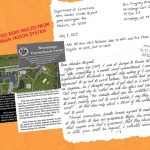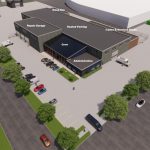Domes sweet Domes
 The news that the domes are back is getting old. But if you haven’t taken the time to visit the revitalized edition of one of the crowning glories of Milwaukee County Parks, you’re missing a real treat. In recent years, the Mitchell Park Conservatory (that’s its official name) had faded. Even though efforts were still put into changing seasonal events, and publicity encouraged visitors to explore this unique wonder, Milwaukee County residents did not think of visiting this treasure (even as a respite in the bleak days of winter.) All of that has changed.
The news that the domes are back is getting old. But if you haven’t taken the time to visit the revitalized edition of one of the crowning glories of Milwaukee County Parks, you’re missing a real treat. In recent years, the Mitchell Park Conservatory (that’s its official name) had faded. Even though efforts were still put into changing seasonal events, and publicity encouraged visitors to explore this unique wonder, Milwaukee County residents did not think of visiting this treasure (even as a respite in the bleak days of winter.) All of that has changed.
More than a year before the renovations started, Milwaukee County Parks Director Sue Black began to court local philanthropists to secure funds for the multi-million dollar project. Chris Abele of Argosy Foundation, Michael Cudahy and an anonymous donor stepped up to the plate. The changes began with a revamping of the entry, lobby and bathrooms at a cost of $250,000. About $500,000 was spent on new LED lighting, landscape lights and colored floods. Air quality was upgraded and more than $2 million was spent on energy-efficient glass to replace the single pane glass installed when the domes were built in the 1960’s.
Domes Director Sandy Folaron sees this rebirth as just the beginning of revitalization for all of Mitchell Park. There are plans for an Urban Agricultural Project (details not yet available), an Evergreen Project (using permeable surfaces for better water absorption) and the use of more green alternatives to “engage a new generation to become excited about what we have.”
Like a phoenix rising from its own ashes, Mitchell Park at 524 S Layton Blvd. has undergone renovations before. Twenty acres were first bought from Sen. John L. Mitchell in 1890. He donated an additional 5 acres, which prompted the city to name the park in honor of the Mitchell family. The park was conceived as a respite from the surrounding industrial landscape. To the north was the Menomonee Valley with its railroads and slaughter houses. To the east and west, there were breweries and factories. It was one of the few areas of the city where there was no public park.
After years of harsh winters and wear and tear, the “crystal palace,” as it had been dubbed, grew so decrepit that it was deemed a hazard and torn down in 1955. Park officials were determined to replace it with an improvement on the original. They envisioned a facility with “separate climates” to showcase a variety of environments for those who may never have the chance to travel to exotic places.
Local architect Donald Grieb came up with a plan in 1958 to use reinforced concrete and skins of glass and aluminum to make four domes (with a nod to Buckminster Fuller, famed designer of geodesic dome structures). Only three domes were eventually built (the missing dome was to house an array of vegetation in a temperate climate). Those that were built are 85-ft high, bee-hive shaped, 145-ft in diameter and house 15,000 square feet of growing space. There is an arid dome, a tropical dome and a “show dome” for changing exhibits. The show dome opened in late 1964, the tropical dome in 1966 and the arid dome in 1967. They cost a total of $4.5 million.
A surge of enthusiasm waxed for the next two decades, as brides had their pictures taken amongst the flowers in the sunken gardens and schoolchildren came to be awed by the majestic palms in the tropical dome. But by the 1980’s, with the sunken gardens replaced by grass in an effort to reduce maintenance, the Domes began to look more ordinary to the public eye.
So what can you expect now?
A breath of new life has come to the lush warmth of the Domes, with a new gift shop in the entrance area, new bathrooms and new plantings.
The Tropical Dome
This dome houses more than 1,200 species of tropical plants, as well as some tropical birds and iguanas. Besides the more familiar banana trees and orchids, you’ll encounter avocado trees, guava trees, ferns, hibiscus, amaryllis, star fruit, ebony and mahogany. There are trails with roots and vines, and hidden benches to sit on and enjoy the landscape. As with the other domes, it is hard to believe so much is packed into so small a space.
The Arid Dome
This dome showcases plants grouped by geographic regions, including Madagascar, Africa, the Canary Islands, South America and the deserts of North America. You will find various representatives of the cactus family (from Saguaro to showy Barrel cacti.) You’ll also see a representative oasis, with date palms and aquatic plants. Here, too, benches are provided to allow you to appreciate this special place.
This space holds temporary displays containing historical, cultural or fantasy elements, which are chosen at least a year in advance. The plants are grown in the park system’s Horticultural Division Greenhouse Center, and the expertise of arborists, artists, carpenters, electricians, plumbers and welders is employed to create each show. There may be miniature trains, a gazebo or a Spanish hacienda, depending on the event.
Excitement over the new lighting and news of the renovation have brought a new surge of visitors, and domes staff have responded with events for them to enjoy. On Thursday evenings this winter, guests were treated to a series of free musical performances called “Music Under Glass.” More may be offered as time goes on.
The changes have also stimulated interest in renting the Domes for special events and weddings (there is a limit of 35 people for some events).
Some of the new exhibits scheduled in the Floral Show Dome are:
• April 4 – May 25, 2009, Spring in Yorkshire: An English Garden
• June 6 – Sept.13, 2009, A Summer in Provence: A view of the French Countryside.
You can also access events and info on scheduling events at: www.countyparks.com.
By Cheri Yarborough




















